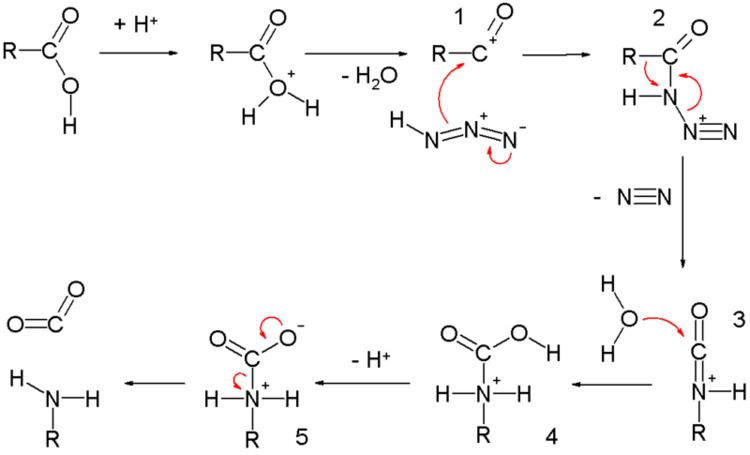Named after Karl Friedrich Schmidt Organic Chemistry Portal schmidt-reaction | ||
 | ||
The Schmidt reaction is an organic reaction in which an azide reacts with a carbonyl group to give an amine or amide, with expulsion of nitrogen. It is named after Karl Friedrich Schmidt (1887–1971), who first reported it in 1924 by successfully converting benzophenone and hydrazoic acid to benzanilide. Surprisingly, the intramolecular reaction wasn't reported until 1991 but has become important in the synthesis of natural products
Contents
Reaction mechanism
The carboxylic acid Schmidt reaction starts with acylium ion 1 obtained from protonation and loss of water. Reaction with hydrazoic acid forms the protonated azido ketone 2, which goes through a rearrangement reaction with the alkyl group R, migrating over the C-N bond with expulsion of nitrogen. The protonated isocyanate is attacked by water forming carbamate 4, which after deprotonation loses carbon dioxide to the amine.
The reaction is related to the Curtius rearrangement except that in this reaction the azide is protonated and hence with different intermediates.
In the reaction mechanism for the ketone Schmidt reaction, the carbonyl group is activated by protonation for nucleophilic addition by the azide, forming intermediate 3, which loses water in an elimination reaction to temporary imine 4, over which one of the alkyl groups migrates from carbon to nitrogen with loss of nitrogen. A similar migration is found in the Beckmann rearrangement. Attack by water and proton loss converts 5 to 7, which is a tautomer of the final amide.
Reactions involving alkyl azides
The scope of this reaction has been extended to reactions of carbonyls with alkyl azides R-N3. This extension was first reported by J.H. Boyer in 1955 (hence the name Boyer reaction), for example, the reaction of m-nitrobenzaldehyde with β-azido-ethanol:
Variations involving intramolecular Schmidt reactions have been known since 1991. These are annulation reactions and have some utility in the synthesis of natural products; such as lactams and alkaloids.
